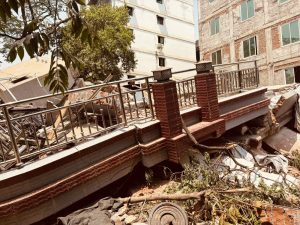On March 28, Myanmar was devastated by a catastrophic 7.7 magnitude earthquake so severe that significant tremors were felt in Bangkok, Thailand, more than 1,000 kilometers from the quake’s epicenter. This shock comes in the midst of an ongoing civil war, and as parts of the country are still recovering from a cyclone that struck in 2023. This recent disaster has only compounded the vulnerability of local communities.
While support systems are nonexistent, the military junta is only further slowing down humanitarian efforts with their aid blockade, restricted communications, and imposed curfews. As of April 3, the death toll had reached 3,085, with at least 4,715 injured and 341 still missing, according to the junta’s likely conservative figures. Thousands more are sleeping on the streets, and lacking basic necessities.
As if the situation couldn’t get any worse, the Myanmar military has launched a series of airstrikes in various parts of the country, only further traumatizing local communities. From March 28 until the present, DVB News reports that the junta has launched over 40 air and artillery strikes across Myanmar, resulting in at least 12 fatalities. The military has made it clear where its priorities lie – and they are not with the people. Instead, the generals seem set on capitalizing on the disaster and using it as an opportunity to beat their opponents into submission at a vulnerable time.
Following the disaster, the National Unity Government issued an urgent call for a two-week ceasefire on March 29 to facilitate humanitarian response efforts. On April 1, this appeal was reinforced by the Three Brotherhood Alliance of ethnic armed groups, which declared a temporary cessation of hostilities to allow for rescue operations and the delivery of critical aid to earthquake-affected communities. On April 2, nearly a week after the earthquake, the military junta finally announced a ceasefire. However, this declaration is being met with significant skepticism. Many relief organizations and local communities remain wary with the understanding that while airstrikes might temporarily cease in the earthquake ravaged central regions of Sagaing and Mandalay, military operations could continue unabated in other parts of the country.
Rather than spend their time and energy on search and rescue teams for trapped civilians, or on delivering much-needed humanitarian aid, the generals have yet again chosen violence. On April 1, junta soldiers fired at a Chinese Red Cross convoy that was escorted by the Ta’ang National Liberation Army in eastern Shan State en route to Mandalay. With the military doing little to coordinate search and rescue efforts, civilians have instead relied on one another for life saving assistance. Local communities have had to utilize manual tools, including their bare hands, to lift rubble and rescue trapped survivors.
As the international community rallies to provide aid, organizations must ensure that this support directly reaches affected civilians on the ground. Financial and material assistance sent to the junta is at risk of being utilized by the military for its own gain and/or to further perpetuate violence against civilians. In a statement on March 28, the U.S. Campaign for Burma pointed out that the military has historically proven itself to be incapable of effectively and indiscriminately distributing humanitarian aid during natural disasters.
The Myanmar military junta’s current prevention of international humanitarian aid for earthquake victims in Sagaing mirrors their deadly playbook from 2008’s Cyclone Nargis, when they blocked critical relief efforts while thousands perished. These two catastrophes highlight how the regime prioritizes maintaining its control over saving civilian lives by deliberately weaponizing natural disasters against its own people. By restricting access during the crucial first 72 hours – when most lives could have been saved – and forcing aid through military channels, the junta deliberately delayed rescue operations following both disasters.
This calculated delay during the “golden window” for survival served their strategic interests in punishing resistance strongholds, forcing compliance from desperate survivors, and reasserting control over contested regions. The pattern reveals how the regime systematically transforms catastrophes into opportunities for further oppression, using human suffering as a tool while thousands of trapped victims perish needlessly under their corrupt humanitarian response.
Effective channels must be established with local organizations on the ground, which are most aware of the situation and know how to reach affected areas. For years, even before this disaster, these local actors have successfully delivered aid to communities most in need, even in areas considered “inaccessible” by the junta.
Foreign governments and international organizations must categorically reject the military junta’s demand that it control aid distribution and establish direct funding mechanisms with local actors, such as community-based organizations and civil society organizations that are directly supporting quake-affected areas. The international community must also enforce sanctions against military regime officials for obstructing emergency aid response. Additionally, world leaders must demand the immediate cessation of airstrikes and military operations, especially in earthquake-affected regions.
This earthquake has once again exposed the fact that the military junta is not only incapable of governing Myanmar, but is actively working against the survival of its own citizens. Only by bypassing this illegitimate regime and working directly with Myanmar’s resilient civil society can effective humanitarian aid reach those fighting to survive both a natural disaster and a man-made tyranny.
































